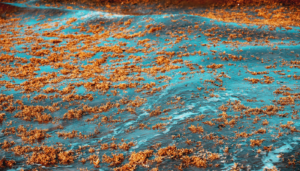
Have you ever wondered about the seaweed benefits for skin? With the rise of TikTok and an inside look into social media user’s daily routines (we’ve all seen the “get ready with me” videos), skin care product use and recommendations have skyrocketed over the past few years with new skincare lines seemingly popping up overnight. We’ve all heard about the cult favorite, coveted ingredients of hyaluronic acid, peptides, snail mucin, and more – but more recently, we’ve started to hear about the amazing seaweed benefits for skin.
From high moisturization to anti-aging, let’s take a closer look at why this ingredient is making waves – pun very much intended – in the skin care industry.
Seaweed Benefits for Skin: Why is Seaweed Becoming Such a Popular Ingredient?
Seaweed, which has often been regarded as oceanic waste by Western cultures, has recently gained popularity as an emerging skin care ingredient due to its numerous beneficial properties and being rich in nutrients. The benefits are widely seen across the three main classes of seaweed, which leads us to…
What are the Three Main Classes of Seaweed?
Did you know that there are multiple types of seaweed? For the purposes of this article, we’ll introduce you to three main classifications you’ll come across as you dive deeper into the seaweed world:
Green algae
Green algae comes in a number of sizes ranging from microscopic organisms to large, multicellular formats. It is mostly found in freshwater habitats, but can also be present in marine environments at times. This green seaweed gets its color from chlorophyll, and plays a vital ecological role in freshwater ecosystems as a main food source for a number of freshwater species.
Red algae
Red algae – scientifically known as “rhodophytaæ” – is the type of seaweed you’ll find washed ashore in coastal areas around the world. Characterized by its reddish/brown color and its unique look and feel, presenting almost sheetlike in its format and not possessing any roots, leaves, or stems, red algae helps to stabilize coral reefs and also has a number of useful applications.
From a unique ingredient in the food industry, to a cosmetic enhancement or its biomedical applications, red algae is a unique and helpful class of seaweed.
Brown algae
Last, but certainly not least, is brown algae – a.k.a. “phaeophyta.” This class of seaweed is marine-based, typically found in cooler seawater environments and very common on the Eastern seaboard of the United States. It varies in size, ranging from large floating islands to underwater forests.
For the purposes of our conversation today, we’re primarily going to be focused on brown algae – and more specifically we’re going to discuss sargassum, which is a species that falls under the brown algae umbrella.
What is Sargassum?
As noted above, sargassum is a type of brown seaweed that is typically found in the Atlantic ocean. In recent years, due to climate change, sargassum has caused quite a stir as sargassum seaweed blooms have multiplied at alarming rates, washing up onto shores and choking out coastal ecosystems.
These large floating masses of seaweed – known as sargassum rafts or islands – aren’t harmful until they get closer to the shore. However, once on shore, they start to degrade, releasing harmful carbon dioxide into the air.
Scientists have been studying sargassum’s makeup to understand its potential uses and upcycling opportunities. In particular, Carbonwave has found a proprietary extraction method that processes sargassum in a way that doesn’t use solvents, which is easier on the earth and allows for the seaweed to retain all of its good properties to become a multifunctional ingredient.
This ingredient has enabled Carbonwave to develop the first-ever natural cosmetic emulsifier that is not made in a lab – instead, it’s made from seaweed. We call it SeaBalance. Now that we’ve covered the basics, let’s take a closer look at the compounds found in seaweed that make it a great – dare we say, excellent – addition to your skin care routine.
What Compounds Found in Seaweed Are Useful for Skin Care?
The compounds and nutrients found in brown seaweed (namely sargassum) that make it great for skin include:
- Fucoxanthin: Fucoxanthin is another word for the brown pigment in this class of seaweed and protects the skin from oxidative stress caused by free radicals, environmental pollutants, and UV rays.
- Amino acids: Amino acids serve as a UV-absorbing compound that helps shield the seaweed from the harmful effects of UV radiation. In turn, when used in skin care, amino acids are a natural defense mechanism against UV radiation.
- Polysaccharides: Brown algae contains a number of polysaccharides that are well-documented for their biological activity to help the skin collect and retain water. The specific polysaccharides that do this include:
- Fucoidans have immense moisturizing properties that may help improve the skin’s hydration levels by attracting and retaining moisture.
- Alginate forms a gel-like texture when in contact with water, making it useful as a natural thickener, stabilizer, and emulsifier in skin care formulations. This compound makes for a great texture in a number of skin care products.
- Laminarin also has moisturizing capabilities that improve the skin barrier, protecting it from damage, and preventing dryness.
- Polyphenols: Known for their antioxidant and anti-aging effects, polyphenols help neutralize free radicals, reduce oxidative stress, and help prevent premature aging.
- Numerous vitamins and minerals: From vitamin E to vitamin C, calcium, potassium, magnesium, and more, brown seaweed contains a number of highly beneficial nutrients that help people maintain and revitalize healthy skin. Many of these nutrients have antioxidant and antiinflammatory properties, making them excellent for skin needs.
While we’ve given a little snapshot on how each of these compounds contributes to healthier skin, let’s go a little deeper on the six key benefits of seaweed in your skin care routine.
The 6 Key Seaweed Benefits for Skin
1. Moisturization and hydration
With the ability to attract and retain moisture, seaweed naturally hydrates the skin and helps prevent dryness. As we grow a better understanding of how the skin barrier works and what we can do to improve hydration on the skin surface, seaweed is becoming a popular skin care ingredient, particularly in moisturizers and face masks.
2. Antioxidants and antiinflammatory properties
Since we’re all subjected to various free radicals and harmful compounds that live in the air we breathe, it’s important to protect our skin as much as possible. Seaweed is naturally rich in antioxidants, (e.g., vitamins C and E) that help calm irritated or inflamed skin.
This is particularly important in skin care ingredients for acne-prone skin that naturally want to promote healing properties through healthy ingredients. Because of the harsh environment sargassum thrives in – direct sunlight – it’s been shown to have even higher levels of antioxidant and antiinflammatory properties, making it a superb addition to a skin care regimen.
Which also leads us to…
3. UV protection
Given the high levels of amino acids found in brown seaweed, like sargassum, having seaweed in your skin care products is a natural UV protector against harmful rays. Not only will this help protect your skin from cancer, but it also helps prevent premature aging caused by the sun. Win, win.
4. Brightening
Seaweed contains natural brightening agents (e.g., phlorotannins) that may help even skin tone, reduce dark spots, and prevent hyperpigmentation if you’re susceptible to it.
5. Collagen boosting
As we age, our skin naturally produces less collagen, eventually causing the skin to sag or deflate. However, seaweed has been shown to support collagen production on the skin surface, and may improve elasticity of the skin. In addition to your collagen powder that you may be stirring into your morning coffee, consider a skin care line with natural collagen boosting ingredients like seaweed.
6. Firming
We’d be remiss not to mention that all of the above also contributes to the firmness and presentation of your skin. Seaweed naturally helps promote a firmer, more youthful skin texture.
Why the Extraction Process Matters for your Skin Care Products
In addition to choosing the best possible inputs for your skin care products, it’s equally important to choose a product that has a sound extraction process. Why? Well, the extraction process impacts the quality of your skin care ingredients. Plain and simple. By choosing a skin care ingredient with a sound extraction process, you can be more certain that your product’s beneficial ingredients are intact and effective for your skin barrier. Plus, harmful extraction processes may actually input ingredients into your skin care products that combat all the benefits we just discussed.
Curious what the extraction process is for your current skin care products? Check out the company’s website, the label on your product, or contact a customer service agent to learn more.
Choose a Natural Emulsifier for Your Skin Care Routine
At SeaBalance, our sustainable and proprietary green chemistry process creates an oil-in-water emulsifier that works well in both cold and hot processed skin care products. Our process is lighter on the earth and lighter on your skin.
Want to learn more about the first-ever seaweed-based natural emulsifier? Get in touch with our team today.



